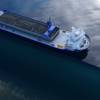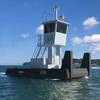By Daryl C. Smith, 1st Naval Construction Division Public Affairs
NORFOLK (NNS) -- The Naval Construction Force will soon have a new, 21st century convoy training simulator to augment current training for Seabees.
Lockheed Martin was recently awarded a contract that includes a state-of-the-art $5 million combat convoy simulator (CCS) expected to be delivered to Construction Battalion Center (CBC), Gulfport, Miss., in September 2008. The trainer is part of a $52.5 million contract providing convoy simulators to the Marine Corps.
The system consists of six vehicle simulators, four high-mobility multipurpose wheeled vehicles and two medium tactical vehicle replacements, that will be programmed with a variety of training scenarios and scenery projected onto a 360-degree screen.
"These are the actual vehicle cabs, not mock-ups," said Rich Morrison, training systems manager for the training department at the 1st Naval Construction Division in Norfolk. Wireless weapons systems and communications gear are also included.
Each vehicle may accommodate a crew of up to five personnel, allowing 30 students to be trained at a time. Each vehicle is positioned in its own simulation space surrounded by a projection screen which displays the other vehicles within the convoy as it progresses through the simulation. Drivers will navigate their vehicles through hostile, life-like scenarios while passengers take appropriate actions.
The facility uses the Firearms Training System, providing realistic weapons firing simulation that registers "hits" on the screen. Since the weapons are wireless, the students have the freedom to move outside and around the vehicles. Although the vehicle cabs are stationary, the sense of movement is maintained by the video projection and sound feedback. As the vehicles move over hills and around corners, the scenery also moves, providing the real sense of riding in the vehicle.
Upon completion of the scenario events, an after action review will be conducted using portions of the recorded mission. This recording will be played back providing instant feedback, allowing students to better understand if their actions were done correctly. The system allows for each scenario to be set up differently with on-the-fly changes.
"The potential of this technology is unparalleled," said Jim Craig, vice president of ground, maritime and civil solutions, Lockheed Martin Simulation. "We are able to adjust scenarios presented on the convoy trainers, allowing our customers to prepare for an ever-growing range of simulations."
Due to limited opportunities for Seabees to train with real vehicles in the field, the CCS is intended to augment live convoy security element training, but will not replace it. "The simulators allow our Seabees to hone and further develop their convoy operations skills learned during live training events helping to prevent skill degradation," Morrison said.
The first system will initially be housed in a temporary building set up by Lockheed Martin at CBC Gulfport. It will eventually be moved into a permanent training technology building that will house additional training equipment and systems.
Plans are under way to purchase another convoy simulator for the Seabee base at Port Hueneme, Calif., when funding becomes available.
Featured videos

Inside the Electrified Truckable Tug

Inmarsat Enhances Service to Drive Digitalization

Tracking Foreign Vessels Working in the U.S. Jones Act Market
Subscribe for
Maritime Reporter E-News
Maritime Reporter E-News is the maritime industry's largest circulation and most authoritative ENews Service, delivered to your Email five times per week









